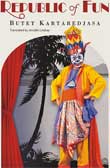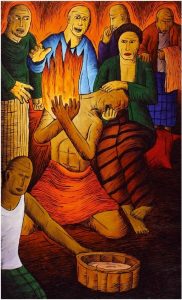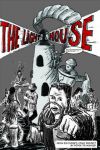
Today is election day in Indonesia. The voters in one of the biggest democracies of the world (and also the country with the biggest Muslim population) elect a new parliament. It will be noted in the Western media if the political parties close to SBY or Jokowi (Indonesians love to call their politicians by short nicknames) have won and if the election process went on without major problems and irregularities.
But beside from that there is usually not much in our media about the biggest archipelago in the world, a country that resembles more a continent in terms of its variety of cultures, religions, languages, or (endangered) biodiversity. We hear from this country normally only after another big natural disaster (tsunami, earthquake, volcano eruption) has struck it or when holiday time is approaching and we are presented another report about the “exotic” island of Bali, also an endangered paradise. Only recently two new topics have popped up that made it to our news: the Indonesian childhood of the present US President and the ruthless activities of the palmoil and extraction industry that is destroying the livelihood of millions and the natural habitat of many endangered species like the Orang-Utan.
I admit it: when it comes to Indonesia I am a bit emotional. After I arrived in 2009 for the first time in the country, I almost immediately fell in love with this tropical country and its warm and genuinely friendly people. And after two very happy years in Yogyakarta, the center of Javanese culture, it was clear to me that I will come back to this place as frequently as possible.
Of course it is impossible to describe the fascination of Indonesia in a short blog like this. Nor is it possible to give an impression of the life of contemporary Indonesians here in general. But considering the fact that Indonesia is somehow a success story in recent years: a 250-million people of incredible variety got rid of a corrupt authoritarian regime in a comparatively peaceful way and without military intervention from abroad, established a quite robust democratic system with citizens that are no longer afraid to voice their opinions, with millions of Indonesians nowadays moving slowly up the social ladder into an emerging middle class, with arts, literature and any other form of human expression and creativity booming, and with media that don’t shy away from touching topics that were taboo for a long time, such as the excellent “Tempo”, or with documentaries such as “The Act of Killing”, touching on the genocide following the putsch against Sukarno in the mid 1960s which killed a probably 7-digit-number of people, most of them completely innocent of communist sympathies or with the intention to plot against Suharto’s government. Even regarding the colorful personality of Tan Malaka, a more differentiated public discussion is possible nowadays. Considering all this and also the general very fast shifting of economic and political power to South-east Asia, I think it is worth it to start reading a bit about this country.
A small book called “Republic of Fun” (and it is really fun to read it) is now on my table that gives an excellent insight in the daily life of contemporary middle-class Indonesians. It is a collection of pieces that was written by Butet Kartaredjasa for the Sunday edition of a newspaper in Semarang, Central Java. Butet is in Indonesia a very well-known actor, not only on stage but also in countless movies and TV productions. He is also a director, a painter (his father Bagong Kussudiardja was a famous dancer and painter), a successful businessman (he founded several advertisement companies) and a journalist and writer as well. “Republic of Fun” and its predecessor “President of Ridicule” introduce to us the Blurt family (obviously shaped on the basis of the author’s own family): Mr. and Mrs. Blurt and their three children “Brother Chubby”, “Miss Tomboy”, and the youngest, 12-year old “Miss Trendy”. Problems within the family, education issues, health problems, but of course also politics and everyday occurrences form the backdrop of the short pieces that have titles such as “Stopping Violence”, “Scary Statues” (on the fake policemen statues that remind drivers to stick to the traffic rules), “Free University”, “Indonesian Obama”, “Steel Chastity Belt” (on the new Anti-Pornography Bill), “The Koi Tragedy”, and others. Once the cast is introduced, the reader likes to come back because he feels already connected and kind of part of the Blurt family. How is the friendly quarreling between Mr. and Mrs. Blurt going on, which of the children will create a problem this time, and what foolishness or corruption of the country’s political elite he will expose this time? Of course it is not the soap opera quality of these pieces and the admittedly very relaxed attitude of this family man (the people from Yogyakarta, Butet’s hometown seem to me to be the most laid-back people on this planet) alone that make these pieces such a nice and entertaining read. It is the ability of the author to catch a problem precisely and to put it in the form of a witty dialogue or funny little story.
But there is also something very serious behind these pieces. “Steel Chastity Belt” for example starts with a dialogue between the usually ironic Mr. Blurt and his more positively-minded wife. But just this once, Mr. Blurt seems to be satisfied with his politicians.
‘Wow, my representatives in parliament are really something. Top class’, Mr Blurt said, putting on a serious expression. So – what’s going on then, that suddenly he’s so positive? It seems he’s been shaken by the ‘achievements’ of the Members of Parliament who have just finished drawing up the new Anti-Pornography bill that will be ratified soon. And if those MPs are spending time managing things that need no managing, then doesn’t that mean that real problems have all been solved? And doesn’t it also mean that more important, pressing matters have been wiped from the face of Indonesia? Crucial issues to do with the people and the State – like the rise in numbers of the poor, rampant corruption, the collapse of the legal system, the totally chaotic public services, the injustice of mining contracts, the collapsed health system – all these have to been solved.’
In the second half of the piece Butet comes to the really shocking content of this new bill that seems so extremely important that for many months it made the headlines in Indonesia: the first clause of the bill says that
‘anything that is categorized as inciting lust has to be wiped out…It’s not clear just how the bill measures someone’s ‘lust’. And who or which institution will do the measuring, and using what scale.’
Tight women’s clothes, even the use of lipstick or a smile, not to speak about any work of art that deals with the human body, can fall under this incredible law.
‘So, in readiness for this disgusting bill, Mr Blurt is preparing two things. Number one, he wants to order a steel chastity belt for himself to protect his sacred ‘family jewels’ from displaying any untoward aggressive excitement. Number two, Mr Blurt just wants to pray. ‘Please let those who drafted this bill based on such disgusting thinking, which insults all women, be cursed by their own mothers for what they have done.’
“Reading Republic of Fun makes me hear again the voice of Indonesia I remember from my childhood”, claims a certain O. Bama, and an obscure S.B. Why has “Three thumbs up”.
“Life is just dropping by for a laugh.”
Butet Kartaredjasa: Republic of Fun, translated by Jennifer Lindsay, Red and White Publishing, Jakarta 2011
© Thomas Hübner and mytwostotinki.com, 2014. Unauthorized use and/or duplication of this material without expressed and written permission from this blog’s author and/or owner is strictly prohibited. Excerpts and links may be used, provided that full and clear credit is given to Thomas Hübner and mytwostotinki.com with appropriate and specific direction to the original content.






 Facebook
Facebook RSS
RSS Twitter
Twitter